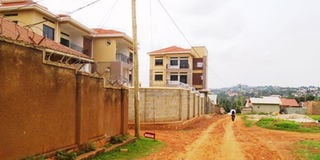Bajjo: A big bush that morphed into a secure residential area

Some of the newly constructed apartments in Bajjo. PHOTO BY FRED MUZAALE
What you need to know:
During stints of heavy traffic between Mukono and Seeta, you may have been driven on a grimy road through Ntaawo stage via Mukono Parents and Paul Mukasa schools. You definitely passed through Bajjo, a residential area and business centre that was one big bush many years ago.
Many shunned the place back then even when land was almost at a giveaway price because it was evidently inhabitable for humans. Bajjo, located in Njenje ward, Goma division in Mukono municipality, has now morphed into a secure residential area since its transition from a rural sub-county to a municipality in 2006. It is a fast growing residential area about a Kilometer away from Seeta town and three kilometres from Mukono town. In January, the area was estimated to have about 2,000 occupants, excluding children in the two schools, among others.
In the 1920s, Bajjo was divided into two blocks, 106 and 100. Block 106 was about one square mile of a bushy area, owned by a single individual. The second block (100), is commonly known as majaani (tea estate) by locals. Land in the two blocks were sold off at pretty affordable amounts back them. Wilson Lugonda 82, a businessman born in Bajjo is one of the locals who have witnessed Bajjo’s growth. Both blocks now have powerful residential homes and housings estates.
Developments
Lugonda narrates: I left my parents’ home and bought land near them (in block 106) from the landlord Eliasafi Kafeero, a peasant. One acre at that time cost Shs 300,000, with surveying costs inclusive. This whole area was a bush and other areas were covered by natural forests, coffee and banana plantations.
Since Lugonda’s piece of land was basically a forest, he was forced to clear it and grow bananas before constructing his house. He now owns a number of rentals in the place. It has grown into a trading centre, with several retail shops. Lugonda fends for his family from proceeds from his shop and rent.
A number of people have flocked the area as a result of the growing industrial area in Namanve, where most of them work. Bajjo LC 1 chairman, Angello Mukasa, says most people living in in the area are staying in their own house and a number of them are continually putting up houses for rent.
Mukasa recalls: When I came here in 1991, I was surrounded by a forest. There were no schools and we only had village paths. 26 years ago, an acre of land was about Shs1m, and a 50 by 100 plot was about Shs125,000. Currently, one has to part with between Shs 25m and Shs50m for the same, implying that an acre costs an arm and a leg. But where can you get an acre in one piece now? Unless you buy from third parties or displace residents. There are more than 10 schools. When I arrived here, there was only a lower primary, church-based school.
Rent and accommodation
Many years ago, one would walk up to a landlord and tell him to sell them a portion of their land. Now, you have to use brokers because you cannot see any land within let alone knowing their owners. Similarly, you need a broker to find a house in this area.
“Many landlords are neighbours to their tenants due to high demand of housing. But unlike back then, one cannot construct a house without an approved plan. So the village is getting more organised,” notes Mukasa, a landlord as well.
Low income class seems to mainly occupy non self-contained, either single or often two roomed houses. Renting a single room is between Shs40, 000 to Shs100, 000, a two- roomed house costs for Shs150,000 while a self-contained double room costs betweenn Shs250,000 to Shs350,000. There is pressure on housing units and many share essential needs such as yard taps. There is piped water and electricity connection. Those that are not connected to water rely on local protected wells their water needs.
Security
Since Bajjo is close to Mukono town, a place well known for all kinds of bizarre occurrences, mischief and iron-bar hitmen, in the past, a number of people will assume Bajjo is insecure, but its leaders and residents prove otherwise.
Charles Setimba, a broker and resident of Bajjo, says Bajjo has been safe for years. “Unlike in the past where thieves would target cars and take spare parts off, you can now sleep without hearing a knock on your door or threats from burglars. ”
Mukasa says there is a Whatsapp network for security purposes so that if anything happens, especially in the night, one gets information really fast and there is action by police. “Members of parliament, OCs, and the RDC are on this platform to ensure security. We are ‘neighbour watch’ to curb crime,” he notes.
Additionally, every household is meant to contribute a security fee of Shs 5000. There are 30 volunteers who are willing, acceptable and physically fit. These patrol together with the police from 11pm till 5am, which makes it hard for burglars to take advantage of sleeping locals.
Telling from Bajjo’s growth, you may want to valiantly invest in a virgin and bushy area, with the hope of reaping many years later.




